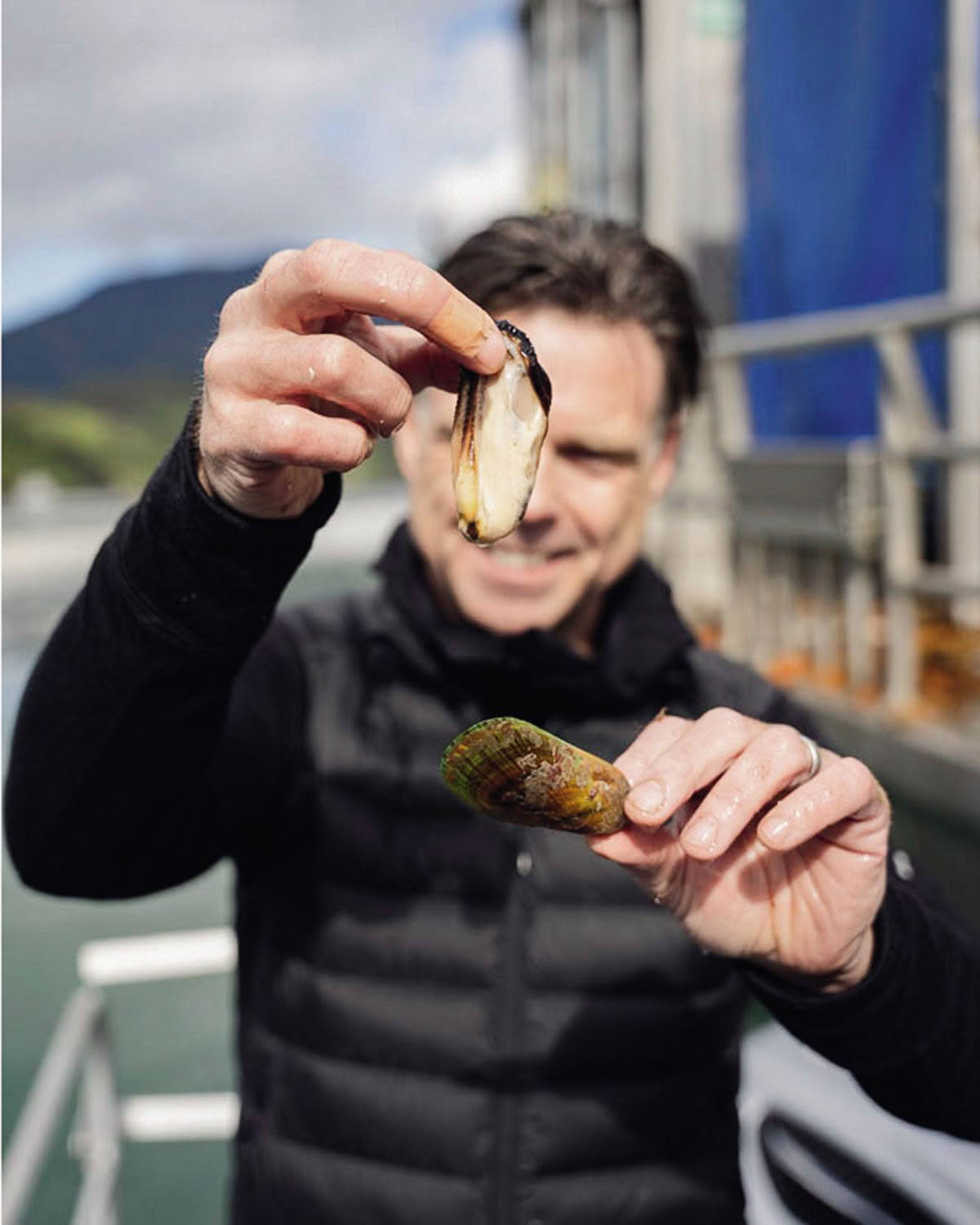I grew up exploring the North Island’s coastlines and mussels were prolific on the rocks, so much so that I never gave them too much thought. I certainly didn’t appreciate their value or importance: they were just there, ready to be picked, to nourish, always available no matter the sea conditions and I didn’t really take advantage. Sometimes in life you don’t see what’s right under your nose. All these years later, the time has come for me to give flowers to the humble green-lipped mussel; it just could be the most underrated ingredient Aotearoa New Zealand produces.
As we drive into the heart of the Marlborough Sounds to learn more about this mollusc for Season 3 of A New Zealand Food Story, I’m wondering how exciting it is going to be? How will this experience inspire a dish on the menu? It could be hard to convince our restaurant guests to order such a low-cost ingredient found in supermarkets.
Reaching Havelock, there’s the well-known sign claiming its green-lipped mussel capital status. I love how our small towns declare themselves the capital of humble products and I truly believe we need to celebrate this culture more! Cromwell is the stonefruit capital, Ohakune has its carrot. These small food capitals give us an insight to the many varied terroirs, climates, soils and bodies of water that we are blessed with, all specialising in growing great ingredients from around the world right here in the regions.
At Havelock Wharf we meet a legend. John Young of Clearwater Mussels is a green-lipped-mussel pioneer who has helped to develop many key technologies for this industry over the past 40 years. First things first, John sets the tone: the Marlborough Sounds are the perfect place to farm and raise fat, plump mussels with calm waters protected from the wind and a vast, steep hill country that feeds rivers such as the Polaris to sweep nutrient-rich water down to the mussels. The length of the Sounds also slows down the tide allowing the mussels more time to filter the nutrients. X marks this spot which is not only the mussel capital of New Zealand, but the world.
Jumping onto the boat and blasting out into the waters to visit one of John’s farms, I’m fascinated to learn that green-lipped mussels are the only native New Zealand animal that we farm. I hadn’t really pondered this concept before and it made me wonder why this was? In any respect, my mind was already back at the restaurant. This fact was surely the first hook in the mussel story we’d relate to our guests – a gateway to the yet-to-be-defined mussel dish, and a big tick for me.
John is an encyclopaedia of knowledge. Green-lipped mussels are filter feeders and grow quickly, only 20-24 months from microscopic spat to maturity. His mussel farm comprises an incredible system. With no intervention, the mussels take advantage of the nutrients already in the water as if they were in the wild and provide a safe habitat for juvenile fish species such as snapper in which to grow. I’m excited to learn that this just may be the most light-footed and sustainable way of farming we have.
These farms employ hundreds of locals and pump $300 million back into the Marlborough economy per year with most of the mussels exported to over 76 countries, including the USA which tops the list.

Cooking wise, they are just so versatile and can be prepared easily in every way. Grill, bake, poach, fry, smoke, pickle – my mind runs through all the methods of cooking I learned in culinary school and mussels work with all, even in a hāngi.
With such an economical price point, they should be on the menu in every restaurant and perhaps should feature in a weekly meal for us Kiwis. The nutritional benefits are vast, too: high in protein and Omega-3 fatty acids, they contain iron, are a natural source of vitamin B12 and are a known anti-inflammatory supplement. I see no reason for our guests not to order them!
With the boat parked up on a remote Marlborough beach, we finish our day with John sitting around a driftwood fire talking as we open, cook and eat these incredible bivalves. This is a true Kiwi sense of place and moment. I can’t help but think how this enlightening experience has helped me come full circle on green-lipped mussels and, more importantly, prompted me to ask, “Are mussels a contender for our greatest New Zealand ingredient?”
They are our very own superfood. Super delicious, super nutritious, super cheap, super environmental, super versatile – and there’s a super story behind them.
The full series of A New Zealand Food Story can be viewed on TVNZ+.
SEE MORE FROM CUISINE
Inspirational Women in Food & Drink
New Zealand’s food-and-drink industry is filled with hardworking and…
We’ve Noticed…. Marcus Verberne
Cooking skills open up a world of different opportunities. From fine…
Design File / Mark Mitchell / Ceramic artist / Northland
In his Northland studio, Mark Mitchell crafts ceramic pieces that use…










